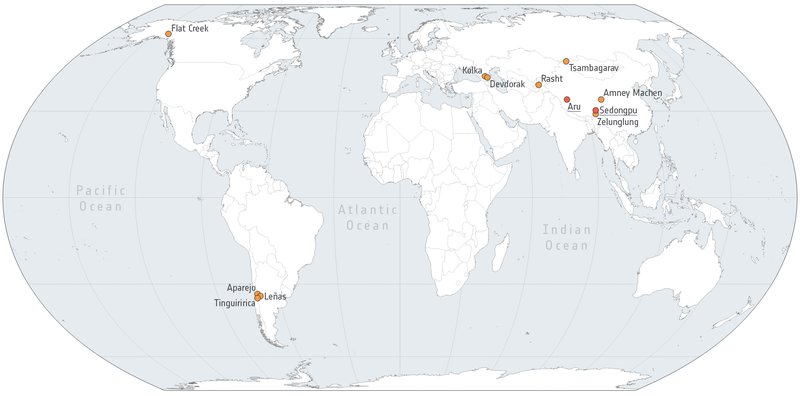10 mai 2021
Low-angle mountain glacier detachments – more frequent than thought?
These events are less rare than thought and may be influenced by a changing climate
Glacier flow is used by scientists as an indicator of climate change. Often perceived to be slow moving bodies of ice, new research suggests that fast and dramatic flows can occur where glaciers are resting on flat, low angle beds. Moving rapidly from about 10 metres a day to speeds, this rate is more akin to avalanches.
Published in The Cryosphere, the research found that such events are less rare than previously thought - and may influenced by a changing climate.
The international research team used high-resolution optical and radar data from satellites including the Copernicus Sentinel-1 and Sentinel-2 missions along with digital elevation models, and involved several members of the ESA Climate Change Initiative glaciers team. They studied 20 glacier detachments that occurred in 10 different regions, in the Caucasus, the Pamirs, Tibet, Altai, the North American Cordillera, and the Southern Andes.

This phenomeon first became made known to the global scientific community first for the 2002 Kolka Glacier in the, Caucasus Mountains and was previously thought to be a unique type of event.
Many of the detachments reached volumes in the order of 10–100 million cubic metres. For the Kolka glacier a 130 million cubic metres of ice and rock detached, killing more than 100 people.
Researching glacier detachment
By analysing the event timing, calculated volumes, run-out distances, elevation ranges, permafrost conditions and other possible factors triggering this type of glacier avalanche, the researchers found such detachments involved a combination of factors related to the lowering of basal friction, high or increasing driving stresses, concentration of shear stress, or low resistance to exceed stability thresholds.
The surface slopes of the detached glaciers range between around 10 and 20 degrees. According to the paper’s authors, this may be low enough to enable the development of thick and thus large-volume glaciers while also being steep enough to allow critical driving stresses to build up.
The researchers were surprised to discover that glaciers resting on flatter beds, such as the Kolka glacier can also detach as a whole.
According to Frank Paul of the University of Zurich and Glaciers_cci Science Leaders, “for some events, we have concluded the effects of a warmer climate, such as permafrost thawing and meltwater infiltration, may well be to blame."
“Although we are still far away from having a prognostic tool to detect possible events before they happen, thanks to satellite data and this new understanding, we might be able to detect precursor signals in good time to potentially save lives.”
Paper reference
Kääb, A. et al. (2021) Sudden large-volume detachments of low-angle mountain glaciers – more frequent than thought? The Cryosphere, 15, 1751–1785, 2021. https://doi.org/10.5194/tc-15-1751-2021

